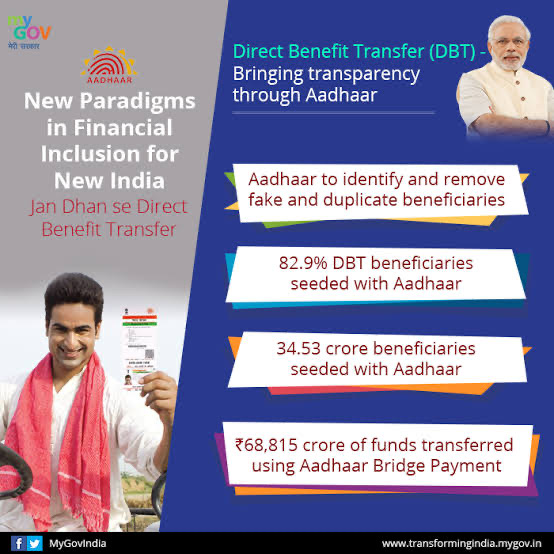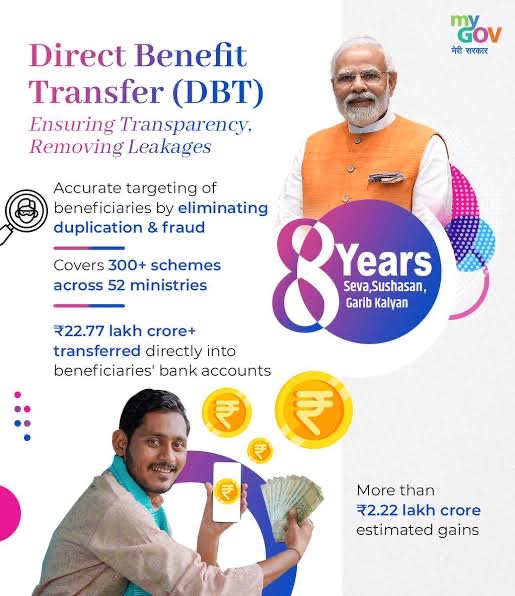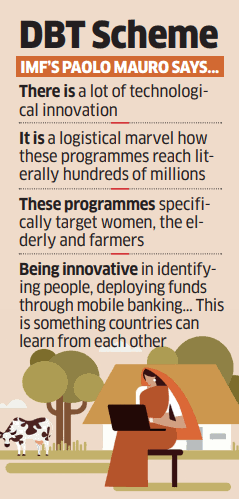ForumIAS announcing GS Foundation Program for UPSC CSE 2025-26 from 19 April. Click Here for more information.
Contents
| For 7PM Editorial Archives click HERE → |
Introduction
Direct Benefit Transfer (DBT) in India has emerged as a pioneering model in ensuring the efficient and effective transfer of government welfare benefits. By leveraging technology and India’s unique identity infrastructure, DBT directly channels funds to beneficiaries’ accounts, minimizing leakages and corruption. It represents a successful amalgamation of public policy and technology, prompting global recognition. As India shares this innovative approach at international forums like G20, DBT’s potential as a global role model for welfare distribution becomes increasingly evident.
What is DBT?

The DBT was envisioned as a system where welfare benefits provided by the government are directly credited to the identified beneficiary’s bank or postal account. Over time, the initiative has expanded, growing both in its scope and coverage.
The scope of DBT has widened: From merely providing cash support to including in-kind transfers. Today, it covers more than 300 Central schemes and over 2000 State schemes. The benefits provided range from cash assistance to in-kind goods and services.
Cash support schemes: such as the Pradhan Mantri Kisan Samman Nidhi (PM KISAN), which supports farmers, and the National Social Assistance Programme (NSAP), providing pensions for the elderly, Divyangjan, and widows. There are also scholarships for deprived sections needing support.
In-kind support schemes: Include the fertilizer subsidy, the Public Distribution System for food grains support, and the Pradhan Mantri Poshan Shakti Nirman (PM POSHAN) which provides mid-day meals for school children.
Use of Aadhaar: DBT schemes employ the use of the electronic ID Aadhaar for identifying and authenticating the intended beneficiaries. During the enrollment of beneficiaries, their Aadhaar details are captured and subsequently authenticated against details stored in the Unique Identification Authority of India (UIDAI)’s Central Identities Data Repository (CIDR).
The frequency of this authentication process depends on the particular scheme. For instance, in the case of PM KISAN, Aadhaar authentication occurs only at enrollment, while for the Public Distribution System, beneficiaries must authenticate their Aadhaar each time they access their quota of grains.
What is India Stack and how DBT in India is integrated with it?
India Stack is a unified platform comprising open APIs and digital public utilities, with the objective to harness the key elements of identity, data, and payments at a large scale. It is essential to understand that Direct Benefit Transfer (DBT) is not a social assistance program in and of itself, but rather a mechanism to consolidate and control data on direct benefit transfers from various sources.
For cash schemes, DBT relies on bank account numbers or Aadhaar-linked accounts to directly transfer social benefits to beneficiaries. In this process, Aadhaar plays a dual role. Not only does it serve as a unique identifier, but also as a financial address. This takes place under the Aadhaar Payments Bridge (APB) system where an individual’s Aadhaar number is mapped against a unique savings bank account, enabling transfers to such accounts using the Aadhaar number as the address.
Furthermore, under the Aadhaar-enabled Payment System (AePS), an individual can use their biometric credentials to carry out banking transactions in Aadhaar-linked bank accounts.
| Read more: DBT Scheme has been beneficial for India in meeting the diverse needs of its population |
What are the benefits of implementing DBT in India?

Efficiency: DBT eliminates intermediaries, ensuring that funds directly reach the intended beneficiaries, making the process faster and more efficient.
Transparency: Since the transfer of benefits is done electronically, it reduces the chances of funds being misused, creating a transparent system of fund allocation.
Reduction in corruption: DBT helps curb corruption by cutting out intermediaries and reducing opportunities for funds to be siphoned off.
Reduced leakages: The program minimizes the leakage of funds that typically occurs in traditional welfare schemes where resources are diverted away from the intended beneficiaries.
Identity verification: Using Aadhaar for beneficiary identification aids in ensuring that the benefits reach the correct individuals.
Reduced expenditure for government: By eliminating wastage, DBT helps the government save significant resources that can then be deployed for other welfare schemes.
Financial inclusion: DBT encourages people, especially from rural and underprivileged backgrounds, to open bank accounts, thus promoting financial inclusion.
Real-time tracking: DBT allows for real-time tracking of fund disbursement, helping identify bottlenecks and areas of improvement.
Empowerment: Direct cash transfers enable beneficiaries to have greater control over their funds, enhancing their decision-making power and overall empowerment.
| Must read: How Direct Benefit Transfer scheme has transformed social welfare in India |
About DBT in India’s role in the G20 agenda
India’s ongoing Presidency of the G20 is committed to being inclusive, ambitious, action-oriented, and decisive. India’s vision is that its initiatives for ‘leveraging technology for citizen welfare’ can lead to a fundamental mindset shift and benefit humanity as a whole. In line with this vision, DBT serves as an exemplary example of Indian innovation. India is seeking to introduce its home-grown DBT paradigm, which is based on Digital Public Infrastructure (DPI), to the world through the G20 platform. The initiative is particularly targeted towards the Global South.
DBT in India is not just a national initiative; it also aligns with India’s broader goals within its co-chairship of the Global Partnership for Financial Inclusion. For its impact on promoting transparency, DBT was also showcased in the G20 Anti-Corruption Working Group Meeting.
| Must read: Direct Benefit Transfer (DBT): Advantages and Way Forward – Explained, pointwise |
How has the World reacted to DBT in India?

DBT in India has garnered international recognition for its significant impact on social welfare and governance reforms.
The International Monetary Fund (IMF) applauds DBT: IMF praised DBT for its scale and logistical prowess in reaching hundreds of millions of low-income individuals. The institution called DBT a ‘logistical marvel’ for the impressive reach of its programmes.
World Bank lauds DBT’s reach and impact: The World Bank also commended the scale at which DBT impacts lives. Owing to DBT’s digital cash transfers, India succeeded in providing food or cash support to an astounding 85% of rural households and 69% of urban households. This achievement is a testament to the efficacy of DBT in reaching large populations with crucial support.
DBT’s contribution to government savings: Beyond its impact on individual lives, DBT and its accompanying governance reforms have significantly contributed to government savings. By March 2021, these reforms had saved the Government of India a cumulative sum of Rs 2.23 lakh crore, which is approximately 1.1% of the nation’s GDP. By March 2022, these savings had increased to Rs 2.73 lakh crore, further emphasizing the economic impact of DBT.
What does the future hold for DBT in India?
The future of DBT lies in two proposed initiatives: DBT 2.0 and DBT 3.0.
DBT 2.0: It aims to streamline the process of verifying eligibility for various schemes. Currently, applicants must submit various eligibility documents or certificates issued by different government departments, which then must be verified by the scheme’s implementing agency. This process can be time-consuming and costly. The new initiative will digitise and link these documents to Aadhaar, ensuring efficient, real-time verification. Platforms such as DigiLocker and API Setu will facilitate access to these certificates in electronic and machine-readable formats. Many states and central government departments have already adopted this system, and efforts are underway to onboard the remaining ones.
DBT 3.0: It envisions a transformative change in the way benefits are delivered to citizens. Currently, citizens must discover eligible government schemes and apply for them to receive benefits. Under DBT 3.0, the government will proactively reach out to eligible citizens based on data from various government databases. The delivery of benefits will commence upon receiving the beneficiaries’ consent.
Several states have implemented ‘Social Registries’, which are databases of beneficiary information, such as Kutumba in Karnataka, Parivaar Pehchaan Patra in Haryana, Samagra in Madhya Pradesh, Jan Aadhaar in Rajasthan, and Social Protection Delivery Platform (SPP) in Odisha. The next step is to establish a national-level social registry that incorporates best practices from state-level initiatives, further revolutionising governance in India.
| Must read: Universal Basic Income: Benefits and Challenges – Explained, pointwise |
India’s Direct Benefit Transfer scheme has revolutionized the delivery of social welfare benefits, ensuring efficient and direct access for beneficiaries while reducing corruption and wastage. Its success has received international recognition, further cementing India’s position as a leader in leveraging technology for social welfare. The future plans for DBT in India promise to build upon its successes, further streamlining the process of benefit delivery and enhancing its impact. Indeed, the DBT paradigm is one of India’s most significant contributions to the global welfare discourse.
Source: Yojana
Syllabus: GS 2: Social Justice: mechanisms, laws, institutions and Bodies constituted for the protection and betterment of vulnerable sections.




